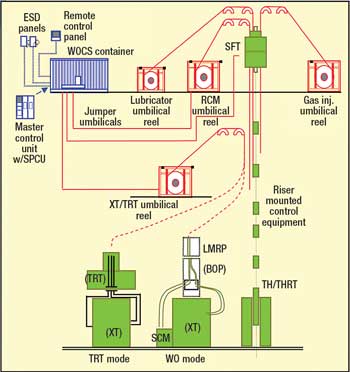Technology from Europe: Norway
Workover control systems prove their merit offshore Norway and Angola
A niche supplier focuses on field-testing and proving workover control systems in the North Sea and other regions..
Juli Jansing, Oil & Gas Project Manager, Commercial Section, Royal Norwegian Consulate General, Houston
Originally operating as the Competence and Service Department within Aker Kvaerner Elektro, Advantec AS was established as an independent company in January 2005. The firm supplies workover control systems (WOCS), among a number of other production and workover-related devices and systems for use on major subsea projects. Upgrading and retro-fitting of WOCS is also provided.
KRISTIN—A FORMIDABLE TESTING GROUND
The firm’s more recent work on Kristin field is a key benchmark for the WOCS technology. Located in the southwestern part of the Haltenbank of the North Sea, Kristin field was originally discovered by Saga Petroleum in 1997, with the ownership passed to Statoil in 2000. Situated in shallow water depths of 360-380 m (1,181 to 1,247 ft), with the reservoir almost 5,000 m (16,405 ft) beneath the seabed, Kristin has high pressures and temperatures. Reservoir pressures are about 911 bar (740 bar, Shut-In Wellhead Pressure (SIWHP)), and reservoir temperatures are around 167°C. Kristin was distinguished as having the highest pressure and temperature of any field developed offshore Norway to date, and one of the most difficult, large HPHT reservoirs under development worldwide.
To meet the extreme circumstances of an HPHT reservoir, the classification requires that the HPHT wellhead equipment be able to withstand pressure greater than 690 bar and/or the formation temperature to be greater than 150°C. The vendor was the main supplier of the WOCS container, umbilicals and the umbilical disconnect system for the project, Fig. 1. All the new system components were subjected to extensive qualification testing and hydraulic fluid compatibility testing for new versions of water and glycol fluids, according to the ISO 13628-6 standard. The firm delivered the first offshore, full-screen operated system to meet the Safety Integrity Level (SIL) requirements, according to the IEC 61508 standard for functional safety of electrical safety-related systems, and the ISO 13628-7 standard applicable to design, analysis, materials, fabrication, testing and operation of subsea completion/workover riser systems run from a floating vessel. The company also provided operational support for the WOCS container.
 |
Fig. 1. Typical multi-purpose workover control system (WOCS), similar to that used on Kristin field, offshore Norway.
|
|
BUILDING EXPERIENCE
Following work on Kristin, the vendor continues to supply WOCS technology and services to North Sea projects on both sides of the border between Norway and the UK, as well as in the Barents Sea. These include options for direct hydraulic versions similar to those used on Kristin and later supplied to Alvheim, as well as for deep and ultra-deepwater applications requiring equipment capable of withstanding extremely high pressures and very low temperatures. At Marathon Oil’s Alvheim field in the North Sea, west of the city of Haugesund and close to the UK border in 125 m of water, the firm was responsible for the design and supply of the IWOCS (Integrated Workover Control System).
In addition to these more recent projects, the vendor has been involved in engineering projects for Vetco Gray Norway on mature, Statoil-operated projects that have been producing since the 1990s. Upgrades were made to the running tools and WOCS models, as part of a gap analysis on completion/workover systems.
BEYOND THE NCS
The firm has also begun supplying WOCS technology into other regions, with a particular focus on West Africa, Asia-Pacific, Russia and the Gulf of Mexico. The standard WOCS is 25 ft versus 30 ft for other systems on the market. With the potential for as little as 20 ft for deepwater versions requiring fewer output lines, and a greater capacity, the direct hydraulic WOCS system can support up to 55 hydraulic control lines, five electrical and four fiber optical lines.
The WOCS also offers multiple completion options in a single system, providing flexibility and allowing a single WOCS container to be used on multiple fields, as needed, with less associated costs. Two options are offered—the open water, lower riser package version, and the landing string version with the software and electronic control system configurable in the software and prepared for the potential change-over. The company has supplied onsite WOCS operational support for projects in Angola, as well as being responsible for testing HPUs for the Dalia project operated by Total. Projects in Asia-Pacific are on the horizon, with India of particular interest, due to the deepwater conditions in that region. 
|



